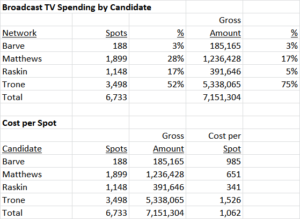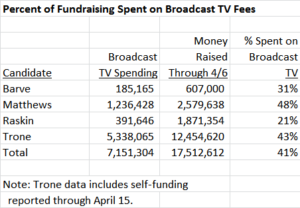The following is a guest post by Adam Pagnucco.
We are now at the end of a record-breaking, historic and extremely expensive Democratic primary for Congress in District 8. The leading category of spending in the race is television advertising. Broadcast TV contracts for political ads are available on the Federal Communications Commission’s website, but they are not readily searchable or crunchable. We tracked and broke down candidate spending on 127 contracts through noon, April 4 three weeks ago. The updated data below pertains to 218 contracts uploaded as of Saturday afternoon, April 23, and should cover almost all broadcast TV spending in the primary.
First, let’s look at the number of spots and gross spending for each broadcaster. This data does not include production costs for the ads, only payments to broadcasters to run them.

WRC-TV, the Washington NBC affiliate, has been the leading network here for years and accounts for roughly a third of spots and more than 40% of gross spending. Its news programs, including the Today Show, the local news shows and NBC Nightly News, are among the most desirable – and most expensive – programs for political advertisers. Three Baltimore broadcasters appear in our dataset because Total Wine co-owner David Trone is advertising on them to reach Carroll County voters.
Television spending has increased steadily since January 26, when Trone kicked off the CD8 2016 ad season. Former WJLA anchor Kathleen Matthews began advertising on February 8. Senator Jamie Raskin joined in on March 24 and Delegate Kumar Barve followed on April 6. April has been a lucrative month for Washington broadcasters, especially WRC.

David Trone is the king of TV spending, accounting for the majority of spots and 75% of gross payments. Trone heavily targets national and local news programs for his ads, considered by many to be solid places to reach voters. Barve prefers these programs too. Matthews keeps her costs down by mixing in cheaper daytime television like The Meredith Viera Show, Days of Our Lives, Who Wants to be a Millionaire, CBS Soaps and The Insider. Raskin runs 15-second spots, half the length of his competitors, and that’s why he has the lowest cost per spot.

Trone has been on TV the longest and has spent the most money by far, but the entrance of other candidates has cut into his dominance a bit. Still, even in April when all spigots were opened, Trone had a 68% market share. Trone spent almost as much on April broadcast TV as Matthews has spent on all items in her entire campaign, and more than Raskin has spent in total.

Despite his unprecedented TV spending, Trone’s campaign is not the most TV-intensive as a proportion of total funds. That distinction belongs to Matthews. Her broadcast TV spending accounts for 48% of the money she raised through April 6. Trone’s TV spending accounts for 43% of his resources (including two late contributions through April 15). Barve and Raskin trail on this measure. Matthews is able to put more of her money into TV, an area in which she excels, because Emily’s List has basically taken over her mail program. This is a significant advantage for Matthews. Aside from the authority line, voters likely cannot distinguish between Emily’s List mailers and anything they have seen from the Matthews campaign.

If spending alone determines the outcome of the race, Trone is going to win. However, about sixty percent of the electorate is female and that will help Matthews. And Raskin’s grass-roots support has been second to none. We are headed towards an exciting finish!
